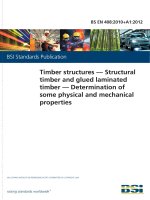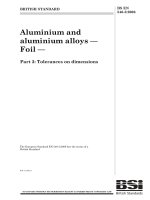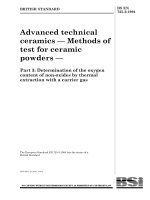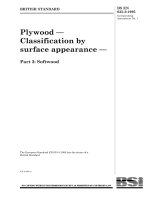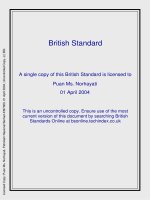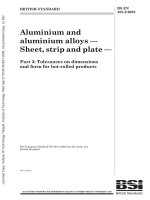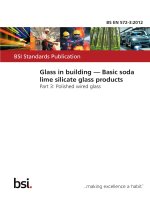Bsi bs en 62282 3 300 2012
Bạn đang xem bản rút gọn của tài liệu. Xem và tải ngay bản đầy đủ của tài liệu tại đây (1.11 MB, 22 trang )
BS EN 62282-3-300:2012
BSI Standards Publication
Fuel cell technologies
Part 3-300: Stationary fuel cell
power systems — Installation
BRITISH STANDARD
BS EN 62282-3-300:2012
National foreword
This British Standard is the UK implementation of EN 62282-3-300:2012.
It is identical to IEC 62282-3-300:2012. It supersedes BS EN 62282-3-3:2008,
which is withdrawn.
The UK participation in its preparation was entrusted to Technical Committee
GEL/105, Fuel cell technologies.
A list of organizations represented on this committee can be obtained on
request to its secretary.
This publication does not purport to include all the necessary provisions of a
contract. Users are responsible for its correct application.
© The British Standards Institution 2012.
Published by BSI Standards Limited 2012.
ISBN 978 0 580 72711 5
ICS 27.070
Compliance with a British Standard cannot confer immunity
from legal obligations.
This British Standard was published under the authority of the
Standards Policy and Strategy Committee on 30 November 2012.
Amendments issued since publication
Amd. No.
Date
Text affected
BS EN 62282-3-300:2012
EUROPEAN STANDARD
EN 62282-3-300
NORME EUROPÉENNE
October 2012
EUROPÄISCHE NORM
ICS 27.070
Supersedes EN 62282-3-3:2008
English version
Fuel cell technologies Part 3-300: Stationary fuel cell power systems Installation
(IEC 62282-3-300:2012)
Technologies des piles à combustible Partie 3-300: Systèmes à piles à
combustible stationnaires Installation
(CEI 62282-3-300:2012)
Brennstoffzellentechnologien Teil 3-300: Stationäre-BrennstoffzellenEnergiesysteme Installation
(IEC 62282-3-300:2012)
This European Standard was approved by CENELEC on 2012-07-19. CENELEC members are bound to comply
with the CEN/CENELEC Internal Regulations which stipulate the conditions for giving this European Standard
the status of a national standard without any alteration.
Up-to-date lists and bibliographical references concerning such national standards may be obtained on
application to the CEN-CENELEC Management Centre or to any CENELEC member.
This European Standard exists in three official versions (English, French, German). A version in any other
language made by translation under the responsibility of a CENELEC member into its own language and notified
to the CEN-CENELEC Management Centre has the same status as the official versions.
CENELEC members are the national electrotechnical committees of Austria, Belgium, Bulgaria, Croatia, Cyprus,
the Czech Republic, Denmark, Estonia, Finland, Former Yugoslav Republic of Macedonia, France, Germany,
Greece, Hungary, Iceland, Ireland, Italy, Latvia, Lithuania, Luxembourg, Malta, the Netherlands, Norway, Poland,
Portugal, Romania, Slovakia, Slovenia, Spain, Sweden, Switzerland, Turkey and the United Kingdom.
CENELEC
European Committee for Electrotechnical Standardization
Comité Européen de Normalisation Electrotechnique
Europäisches Komitee für Elektrotechnische Normung
Management Centre: Avenue Marnix 17, B - 1000 Brussels
© 2012 CENELEC -
All rights of exploitation in any form and by any means reserved worldwide for CENELEC members.
Ref. No. EN 62282-3-300:2012 E
BS EN 62282-3-300:2012
EN 62282-3-300:2012
Foreword
The text of document 105/377/FDIS, future edition 1 of IEC 62282-3-300, prepared by IEC/TC 105 "Fuel
cell technologies" was submitted to the IEC-CENELEC parallel vote and approved by CENELEC as
EN 62282-3-300:2012.
The following dates are fixed:
•
•
latest date by which the document has
to be implemented at national level by
publication of an identical national
standard or by endorsement
latest date by which the national
standards conflicting with the
document have to be withdrawn
(dop)
2013-04-19
(dow)
2015-07-19
This document supersedes EN 62282-3-3:2008.
EN 62282-3-300:2012 includes the following significant technical changes with respect to EN 62282-33:2008:
– addition in the scope to avoid overlapping between EN 62282-3-100 and EN 62282-3-300 concerning
safety related requirements;
– updating normative references and definitions;
– requirements applicable to the stationary fuel cell removed, so that the target of this standard focuses
on “installation risks”;
– level of CO reduced for small fuel cell power systems which exhaust directly into a utility shed where
they are installed, and where the shed is to ensure safety;
– requirement for using a combustible gas detection system modified;
– reference to the gas valve standard ISO 23551-1 added.
This standard covers the Principle Elements of the Safety Objectives for Electrical Equipment Designed
for Use within Certain Voltage Limits (LVD - 2006/95/EC).
Attention is drawn to the possibility that some of the elements of this document may be the subject of
patent rights. CENELEC [and/or CEN] shall not be held responsible for identifying any or all such patent
rights.
Endorsement notice
The text of the International Standard IEC 62282-3-300:2012 was approved by CENELEC as a European
Standard without any modification.
BS EN 62282-3-300:2012
EN 62282-3-300:2012
Annex ZA
(normative)
Normative references to international publications
with their corresponding European publications
The following documents, in whole or in part, are normatively referenced in this document and are
indispensable for its application. For dated references, only the edition cited applies. For undated
references, the latest edition of the referenced document (including any amendments) applies.
NOTE When an international publication has been modified by common modifications, indicated by (mod), the relevant EN/HD
applies.
Publication
Year
IEC 60079-10
Title
EN/HD
Year
Series Explosive atmospheres Part 10: Classification of areas
EN 60079-10
Series
IEC 60079-29-1
-
Explosive atmospheres Part 29-1: Gas detectors - Performance
requirements of detectors for flammable
gases
EN 60079-29-1
-
IEC 60079-29-2
-
EN 60079-29-2
Explosive atmospheres Part 29-2: Gas detectors - Selection,
installation, use and maintenance of detectors
for flammable gases and oxygen
-
IEC 62282-3-100
2012
Fuel cell technologies Part 3-100: Stationary fuel cell power
systems - Safety
EN 62282-3-100
2012
ISO 1182
-
Reaction to fire tests for building products Non-combustibility test
EN ISO 1182
-
ISO 14121
-
Safety of machinery - Principles of risk
assessment
-
-
ISO 23551-1
-
Safety and control devices for gas burners
and gas-burning appliances - Particular
requirements Part 1: Automatic valves
-
-
BS EN 62282-3-300:2012
62282-3-300 IEC:2012
CONTENTS
INTRODUCTION . .................................................................................................................................. 6
1
Scope . ............................................................................................................................................. 7
2
Normative references . .................................................................................................................. 8
3
Terms and definitions . .................................................................................................................. 9
4
General safety requirements and strategy . ............................................................................. 10
5
Siting considerations . ................................................................................................................. 11
5.1
5.2
5.3
6
5.4 Rooftop installation. .......................................................................................................... 13
Ventilation and exhaust .............................................................................................................. 13
6.1
6.2
6.3
7
General . ............................................................................................................................. 13
Ventilation . ......................................................................................................................... 13
Exhaust system . ................................................................................................................ 13
6.3.1 General . ................................................................................................................ 13
6.3.2 Small fuel cell systems . ...................................................................................... 13
6.4 Purging and venting processes . ...................................................................................... 13
Fire protection and gas detection. ............................................................................................. 14
7.1
8
General siting . ................................................................................................................... 11
Outdoor installations . ....................................................................................................... 12
5.2.1 Air intakes and vents . ......................................................................................... 12
5.2.2 Air intakes and exhaust . ..................................................................................... 12
5.2.3 Exhaust outlets ..................................................................................................... 12
5.2.4 Area around outlets ............................................................................................. 12
5.2.5 Enclosures . .......................................................................................................... 12
Indoor installations . .......................................................................................................... 12
5.3.1 General . ................................................................................................................ 12
5.3.2 Small fuel cell power systems . ........................................................................... 13
Fire protection and detection . ......................................................................................... 14
7.1.1 Site fire protection . .............................................................................................. 14
7.1.2 Combustible gas detection (indoor installations only) . ................................... 14
7.2 Fire prevention and emergency planning . ..................................................................... 14
Interconnections with site interfaces . ....................................................................................... 15
8.1
8.2
8.3
8.4
9
General . ............................................................................................................................. 15
Connections to fuel supplies – General . ....................................................................... 15
Fuel shut-off and piping . .................................................................................................. 15
Connections to auxiliary media supply and media disposal . ....................................... 15
8.4.1 General . ................................................................................................................ 15
8.4.2 Combustible auxiliary gases . ............................................................................. 15
8.4.3 Non-combustible or inert auxiliary gases ......................................................... 15
8.4.4 Water . ................................................................................................................... 15
8.4.5 Waste water and condensate disposal . ............................................................ 16
8.4.6 Discharge pipe ..................................................................................................... 16
Environmental requirements ...................................................................................................... 16
10 Approval tests . ............................................................................................................................ 16
10.1 Gas leakage ....................................................................................................................... 16
BS EN 62282-3-300:2012
62282-3-300 IEC:2012
10.2 Site specific shut-down devices . ..................................................................................... 16
11 Maintenance tests ....................................................................................................................... 16
12 Documentation . ........................................................................................................................... 17
12.1
12.2
12.3
12.4
12.5
Markings and instructions . ............................................................................................... 17
Inspection checklist . ......................................................................................................... 17
Installation manual . .......................................................................................................... 17
User’s information manual . .............................................................................................. 17
Maintenance manual . ....................................................................................................... 17
Figure 1 – Fuel cell power system ...................................................................................................... 8
–6–
BS EN 62282-3-300:2012
62282-3-300 IEC:2012
INTRODUCTION
This International Standard covers the installation of stationary fuel cell power systems that
are built in compliance with IEC 62282-3-100.
The requirements of this standard are not intended to constrain innovation. Installations
employing materials and/or methods differing from those detailed in this standard may be
examined and tested according to the intent of the requirements and, if found to be
substantially equivalent, may be considered to comply with the standard.
BS EN 62282-3-300:2012
62282-3-300 IEC:2012
–7–
FUEL CELL TECHNOLOGIES –
Part 3-300: Stationary fuel cell power systems –
Installation
1
Scope
This part of IEC 62282 provides minimum safety requirements for the installation of indoor
and outdoor stationary fuel cell power systems in compliance with IEC 62282-3-100 and
applies to the installation of the following systems:
–
intended for electrical connection to mains directly or with a readily accessible, manually
operable switch or circuit-breaker;
–
intended for a stand-alone power distribution system;
–
intended to provide AC or DC power;
–
with or without the ability to recover useful heat.
This standard is limited to those conditions that may be created by the installation process
that can lead to personnel hazards or damage to equipment or property external to the fuel
cell power system.
This standard does not cover the safety requirements of the stationary fuel cell power system
which are covered by IEC 62282-3-100.
Additionally, this standard does not cover:
–
fuel supply and/or fuel storage systems;
–
auxiliary media supply and disposal;
–
switches or circuit-breakers;
–
portable fuel cell power systems;
–
propulsion fuel cell power systems;
–
APU (auxiliary power units) applications.
A typical stationary fuel cell power system installation is represented in Figure 1.
BS EN 62282-3-300:2012
62282-3-300 IEC:2012
–8–
System boundary
Power inputs
Electrical
Thermal
Mechanical
Fuel
Recovered heat
Thermal
management
system
Fuel
processing
system
Oxidant
Fuel
cell
module
Oxidant
processing
system
Ventilation
Water
treatment
system
Waste heat
Power
conditioning
system
Internal power
needs
Inert gas
Water
Ventilation
system
EMD
vibration,
wind, rain,
temperature
etc.
Automatic
control
system
Onboard
energy
storage
Useable power
electrical
Discharge water
Exhaust gases
ventilation
EMI
noise
vibration
IEC 105/12
Key
EMD electromagnetic disturbance
EMI electromagnetic interference
Figure 1 – Fuel cell power system
Fuel cell power systems are divided into two categories:
–
small systems;
–
large systems.
Terms and definitions are given in Clause 3.
2
Normative references
The following documents, in whole or in part, are normatively referenced in this document and
are indispensable for its application. For dated references, only the edition cited applies. For
undated references, the latest edition of the referenced document (including any
amendments) applies.
IEC 60079-10 (all parts), Explosive atmospheres – Part 10: Classification of areas
IEC 60079-29-1, Explosive atmospheres – Part 29-1: Gas detectors – Performance
requirements of detectors for flammable gases
IEC 60079-29-2, Explosive atmospheres – Part 29-2: Gas detectors – Selection, installation,
use and maintenance of detectors for flammable gases and oxygen
IEC 62282-3-100:2012, Fuel cell technologies – Part 3-100: Stationary fuel cell power
systems – Safety
ISO 1182, Reaction to fire tests for building and transport products – Non-combustibility test
ISO 14121, Safety of machinery – Risk assessment
BS EN 62282-3-300:2012
62282-3-300 IEC:2012
–9–
ISO 23551-1, Safety and control devices for gas burners and gas-burning appliances –
Particular requirements – Part 1: Automatic valves
3
Terms and definitions
For the purposes of this document, the following terms and definitions apply.
3.1
accessible (operator access area)
area to which, under normal operating conditions, one of the following applies:
–
access can be gained without the use of a tool;
–
the means of access are deliberately provided to the operator;
–
the operator is instructed to enter, regardless of whether or not a tool is needed to gain
access.
Note 1 to entry
above.
The terms "access" and "accessible", unless qualified, relate to operator access area as defined
3.2
approved
acceptable to the authority having jurisdiction
3.3
authority having jurisdiction
AHJ
organization, office, or individual responsible for enforcing the requirements of a code or
standard, or for approving equipment, materials, an installation, or a procedure
3.4
exhaust
gases removed from a fuel cell power system and not reused
3.5
exhaust system
gas-conveying system for moving gases from a source to a point of discharge
3.6
fire prevention
measures directed toward avoiding the inception of fire
3.7
fire protection
methods of providing for fire control or fire extinguishment
3.8
fire risk evaluation
detailed engineering review of a plant's construction features and operating processes
conducted to ensure that applicable fire prevention and fire protection requirements for
safeguarding life and physical property are met
3.9
forced ventilation
movement of air and its replacement with fresh air by mechanical means
3.10
indoor installation
fuel cell power system completely surrounded and enclosed by walls, a roof and a floor
– 10 –
BS EN 62282-3-300:2012
62282-3-300 IEC:2012
3.11
installation
– location where a fuel cell power system is sited as a unit or built as an assembly
– act to install a fuel cell power system
3.12
large fuel cell power systems
fuel cell power systems having a net electrical output of more than 10 kW
3.13
lower flammability limit
LFL
lowest concentration of a flammable gas/vapour in air in which flame is propagated
3.14
natural ventilation
movement of air and its replacement with fresh air due to the effects of wind and/or
temperature gradients
3.15
non-combustible
not capable of supporting combustion in accordance with ISO 1182 or equivalent method
3.16
outside or outdoor installation
power system installation that is not an indoor installation. When permitted by local or national
regulations, an open-air structure with partial roof and/or walls may be considered an outdoor
installation
3.17
portable fuel cell power system
fuel cell power system that is not intended to be permanently fastened or otherwise secured in
a specific location
3.18
rooftop installation
power system installation located on the roof of a building
3.19
room ventilation
air supply to the room for cooling, heating, makeup atmosphere, safety ventilation
Note 1 to entry
This air can be taken from indoors or outdoors.
3.20
small fuel cell power system
fuel cell power system having a net electrical output up to 10 kW
3.21
stationary
permanently connected and fixed in place
4
General safety requirements and strategy
A fuel cell power system and associated equipment, components and controls shall be
installed in accordance with the manufacturer’s instructions. Based on the quantity of fuel and
other stored energy (e.g. flammable materials, pressurized media, electrical energy,
mechanical energy, etc.) within the fuel cell power systems, there is a need to eliminate
hazards to personnel or damage to equipment or property external to the fuel cell power
BS EN 62282-3-300:2012
62282-3-300 IEC:2012
– 11 –
system as far as rationally possible. The general safety strategy for the installation of the fuel
cell power systems shall be established according to the following sequence:
–
Avoid the possible release of combustible and/or toxic gases and pollutant gases, liquids
and solids.
–
Eliminate hazards to personnel or damage to equipment or property external to the fuel
cell power system and the related installation as far as rationally possible, when such
energy or gases are released almost instantaneously.
–
Provide appropriate safety markings concerning the remaining risks of hazards.
Special care shall be taken to address the following:
–
Mechanical hazards – Sharp surfaces, tripping hazards, moving masses and instability,
strength of materials and liquids or gases under pressure.
–
Electrical hazards – Contact of persons with live parts, short-circuits, high voltage.
–
Thermal hazards – Hot surfaces, release of high temperature liquids or gases, thermal
fatigue.
–
Fire and explosion hazards – Flammable gases or liquids, potential for explosive mixtures
during normal or abnormal operating conditions, potential for explosive mixtures during
fault conditions.
–
Malfunction hazards – Unsafe operation of installation related equipment due to failures of
software, control circuit or protective/safety components or incorrect manufacturing or
misoperation.
–
Material and substance hazards – Material deterioration, corrosion, embrittlement, toxic
releases, choking hazards (e.g. by replacing oxygen by inert purge gases).
–
Waste disposal hazards – Disposal of toxic materials, recycling, disposal of flammable
liquids or gases.
–
Environmental hazards – Unsafe operation in hot/cold environments, rain, flooding, wind,
earthquake, external fire, smoke.
5
Siting considerations
5.1
General siting
The fuel cell power system shall comply with IEC 62282-3-100.
A fuel cell power system(s) and associated equipment, components, and controls shall be
sited in accordance with the manufacturer’s instructions and meet the following requirements:
–
It shall be placed and fixed firmly so that it will not be easily moved, toppled, or dislocated.
–
It shall be located and secured as necessary so that the system and equipment will not be
adversely affected by wind, and seismic events. It shall be protected so as not to be
adversely affected by rain, snow, ice, water and or freezing temperatures, unless the
system and installation equipment is designed for those conditions.
–
Sites for large power systems shall be protected against access by unauthorized persons
if required by the location and installation environment. Fire department access shall be
provided.
–
It shall be located outside of potentially hazardous atmospheres as defined by IEC 6007910, unless approved for the specific installation.
–
It shall be sited so that the power system and equipment do not adversely affect building
exits.
–
It shall be located so that the power system(s) and components of a fuel cell power
system and their respective vent or exhaust terminations are separated from doors,
windows, outdoor intakes and other openings into a building to prevent introduction of
exhaust gases into the building.
– 12 –
BS EN 62282-3-300:2012
62282-3-300 IEC:2012
–
The exhaust outlet(s) shall not present a hazard when directed onto walkways or other
paths of travel for pedestrians.
–
It shall be located in a manner that allows service, maintenance and emergency access.
–
It shall be located away from combustible materials, high-piled stock and other exposures
to fire hazards. Distances and clearances shall be according to regulations given by the
authority having jurisdiction (AHJ).
–
It shall be located or protected to prevent physical damage from moving vehicles or
equipment.
–
Multiple power systems shall be located or protected such that a fire or failure of one of
the systems does not present a safety hazard to adjacent power systems.
–
Where demonstrated by an engineering analysis that the prescriptive requirements in this
clause are unnecessary to achieve an equivalent level of safety, approved alternatives
shall be proposed for permission by the AHJ.
–
Discharged liquids and vapours shall be disposed of according to AHJ.
–
Waterproofing of floors and installation of drainage piping and other appropriate actions
shall be taken when installing a fuel cell power system which is expected to require
drainage.
5.2
5.2.1
Outdoor installations
Air intakes and vents
Air intakes and vents to a fuel cell power system shall be located so that the plant is not
adversely affected by other exhausts, gases or contaminants. Air intakes to a fuel cell power
system shall be kept unobstructed so their flow capacity is not affected by agglomeration of
solids, dust, water, ice and snow.
5.2.2
Air intakes and exhaust
Air intakes and exhaust to and from a fuel cell power system shall not impact travel on
walkways or other paths of travel for pedestrians.
5.2.3
Exhaust outlets
The exhaust outlet(s) from process areas, or areas that contain fuel-bearing components of a
fuel cell power system, including outlets from relief valves, shall be located in such a manner
that it will not affect heating, ventilating, and air-conditioning (HVAC) air intakes, windows,
doors, and other openings into buildings.
5.2.4
Area around outlets
The area around outlets from fuel processes or compartments that contain fuel-bearing
components and relief valves outlets shall be evaluated in accordance with IEC 60079-10.
5.2.5
Enclosures
Security barriers, fences, landscaping and other enclosures shall not affect the required
airflow into or exhaust out of the fuel cell power system and its components.
5.3
5.3.1
Indoor installations
General
Indoor fuel cell power systems and their associated components shall be installed in rooms
that meet the requirements of the applicable national standards.
BS EN 62282-3-300:2012
62282-3-300 IEC:2012
5.3.2
– 13 –
Small fuel cell power systems
Small fuel cell power systems shall not be required to have fire rated separations.
5.4
Rooftop installation
5.4.1 Fuel cell power systems and components located on rooftops shall be installed in
accordance with 5.2.
5.4.2 The material under and within 30 cm horizontally of a fuel cell power system or
component shall be non-combustible or shall be certified to afford an appropriate degree of
fire protection to the roof deck in accordance with national regulations. Exemption is made for
fuel cell power systems complying with 5.12 b) of IEC 62282-3-100:2012.
6
Ventilation and exhaust
6.1
General
All indoor fuel cell power systems shall be provided with adequate ventilation and exhaust
systems.
The intakes and exits of the ventilation and exhaust systems shall meet the requirements
specified in 5.2.1, 5.2.2 and 5.2.3.
6.2
Ventilation
Air that is supplied to the room where the fuel cell power system is located, whether taken
from the vicinity of the appliance, an adjacent room or outdoors, may serve as ventilation air,
process air or both. This air shall be supplied by either a forced ventilation system or natural
ventilation in accordance with the manufacturer’s installation instructions.
If forced ventilation is required for safety during normal operation, a control interlock shall be
provided to alarm and/or shutdown the fuel cell power system upon loss of ventilation.
6.3
Exhaust system
6.3.1
General
Fuel cell power systems shall have a dedicated exhaust system according to IEC 62282-3-100
that discharges the emissions outdoors.
6.3.2
Small fuel cell systems
Small fuel cell power systems may exhaust directly into a utility shed, where they are
installed, if the shed
a) is unattached from a building or attached without direct access to the building’s occupied
areas, and
b) has an interlocked ventilation system, or natural ventilation, that has sufficient flow to
ensure, under all circumstances, that it will prevent
1) concentrations of air free CO higher than 50 × 10 –6 under normal working conditions,
2) values greater than 25 % of the relevant LFL, and
3) oxygen concentrations below 18 %.
6.4
Purging and venting processes
6.4.1 Pressure tanks and piping intended to be purged, pressure regulators, relief valves,
and other potential sources of combustible gas shall be vented to the outside of the building
– 14 –
BS EN 62282-3-300:2012
62282-3-300 IEC:2012
in accordance with 5.2.3. For small fuel cell power systems, purging is permitted into room
atmosphere, if it is ensured, that a maximum 25 % of the relevant LFL will not be exceeded
and that the atmosphere will not exceed 50 × 10 –6 of air-free CO anywhere in the room.
6.4.2
7
The vent shall be designed to prevent entry of water or foreign objects.
Fire protection and gas detection
7.1
Fire protection and detection
7.1.1
Site fire protection
Sites that have flammable or combustible liquid fuel storage shall be protected in accordance
with national regulations.
7.1.2
Combustible gas detection (indoor installations only)
7.1.2.1 A combustible gas detection system shall be installed in the fuel cell power system
enclosure or fuel cell power system exhaust system or in the room containing fuel cell power
system installations. Location of gas detection systems in the room shall be chosen to provide
the earliest warning of the combustible gases present.
Location of gas detectors shall be in accordance with IEC 60079-29-2.
The requirements for the gas sensors are defined in IEC 60079-29-1.
The combustible gas detection system is not required for fuel cell power systems that are
•
fuelled with odorized gas, or
•
fuelled with non-odorized gas, such as hydrogen, from bottles of limited capacity
according to relevant national standards such that they can be stored indoors without
special ventilation.
7.1.2.2
The following criteria for combustible gas detection systems shall be met:
a) The combustible gas detection system shall be arranged to alarm at 25 % of the lower
flammability limit (LFL) and be interlocked to shut down the power system fuel supply at
50 % of LFL, respectively.
b) The LFL used shall be the lowest flammability limit of the gas or gas mixtures.
7.1.2.3 A combustible gas detector that meets the requirements of 7.1.2.2 shall be provided
for all indoor or separately enclosed gas compressors. Exempted are separately enclosed gas
compressors, provided that the room ventilation ensures combustible gas concentrations
lower than 25 % of LFL.
7.1.2.4 The room or area where the fuel cell power system is installed shall have a
combustible gas detector located according 7.1.2.1 if non-odorized gas, such as hydrogen, is
piped into the room or area from outside. The gas detection system shall alarm and shutdown
according to the respective limits in 7.1.2.2.
7.2
Fire prevention and emergency planning
For large fuel cell installations, a written fire prevention and emergency plan shall be
provided. This is not required for small fuel cell power systems.
BS EN 62282-3-300:2012
62282-3-300 IEC:2012
8
– 15 –
Interconnections with site interfaces
8.1
General
All interconnections including piping, electrical wiring, disconnections and ducting between
site interfaces and the fuel cell power system shall be in accordance to relevant national
standards.
8.2
Connections to fuel supplies – General
The installation and location of the interface point equipment downstream of the fuel supply
system and the associated fuel piping, including the necessary components and their
connection to the stationary fuel cell power system, shall be in accordance with this clause.
8.3
Fuel shut-off and piping
8.3.1 For indoor installations an accessible manual shut-off valve shall be located within the
room or within 1,8 m upstream of the fuel cell power system, unless the power system is
enclosed by a fire rated room. In that case, the shut-off valve shall be located outside the
room. A second shut-off valve may be located within the room for maintenance. If this second
valve is not provided, and the shut-off is located outside the room, it shall be a lockable type.
8.3.2
For outdoor installations, a single manually operated shut-off valve is required.
8.3.3 Piping, valves, regulators or other equipment shall be located so that they are not
subject to physical damage.
8.3.4 For an indoor installation of a power system being fed by non-odorized fuel gas
mixtures, an automatic shut-off valve according ISO 23551-1, interlocked with gas detection,
shall be located outside the building that houses the power system in accordance with Clause
7. The gas detection system shall be arranged to alarm at 25 % of LFL and be interlocked to
shut down the power system fuel supply at 50 % of LFL.
8.4
8.4.1
Connections to auxiliary media supply and media disposal
General
Different fuel cell power systems need some auxiliary media supply and disposal, for example
normal operation, safety reasons, start-up or shutdown procedures, purging or protection
against internal damages. Water, nitrogen, carbon dioxide and hydrogen are typical auxiliary
media for fuel cell power systems. As storage of these media is not in the scope of this
standard, only the interfaces shall be defined.
8.4.2
Combustible auxiliary gases
Redundant safety systems consisting of a quick-action shut-off valve controlled by the fuel
cell power system’s automatic control system and an accessible second valve with an
additional manual operability in the feed line are required in each system for combustible
gases.
8.4.3
Non-combustible or inert auxiliary gases
Connections according to national standards.
8.4.4
Water
Tap-water, recycled water: connections according to national standards.
– 16 –
8.4.5
BS EN 62282-3-300:2012
62282-3-300 IEC:2012
Waste water and condensate disposal
Connection according to national standards.
8.4.6
Discharge pipe
Connection according to national standards.
9
Environmental requirements
Emissions, contaminants and other environmental loads under normal and abnormal
operation as well as failure modes operation are defined in IEC 62282-3-100.
Requirements for installation and initial commissioning:
The following emissions during installation and initial commissioning shall not exceed levels
as limited by applicable national regulations:
–
noise;
–
toxic and/or pollutant emissions;
–
discharge of construction materials;
–
auxiliary materials;
–
binder burn out gases.
If required by national regulations, adequate facilities to reduce emissions during installation
and commissioning of the fuel cell power system shall be provided and operated.
10 Approval tests
10.1
Gas leakage
A gas leakage test is required for site-installed piping only. The gas leakage test shall be
performed according to relevant national standards.
10.2
Site specific shut-down devices
Shut-off devices required by
–
6.2 (forced ventilation),
–
6.3 (forced exhaust),
–
7.1.2.1 and 7.1.2.4 (combustibility sensor),
–
8.3.4 (non-odorized gas shut-off valve),
shall be demonstrated to function properly.
11 Maintenance tests
Procedures shall be in place for maintenance tests of site-installed items, as required for
normal periodic maintenance, that will be performed according to the manufacturer’s
instructions and national regulations.
Deficiencies stated during maintenance test shall be corrected immediately by authorized
personnel only.
BS EN 62282-3-300:2012
62282-3-300 IEC:2012
– 17 –
12 Documentation
12.1
Markings and instructions
Interface markings: all interfaces to a fuel cell system shall be clearly identifiable at least by
marking in a local language or by clear symbol indications. Any emergency devices shall be
marked according to the local or national regulations.
All fuel piping covered by this standard shall be marked or identified in accordance with a
relevant national standard.
12.2
Inspection checklist
12.2.1 An inspection checklist shall be included within the documentation package or
contained within the installation manual. The inspection checklist shall be kept by the owner
or operator of the facility.
12.2.2
The installation checklist shall bear the following information:
–
installer’s company name;
–
installer’s name;
–
date of installation;
–
location of fuel cell power system installation.
12.2.3 The installation checklist shall include confirmation by signature of the installer of the
proper installation of the following:
–
fuel supply connection requirements as prescribed in 8.2;
–
gas leakage test results as prescribed in 10.1;
–
connections to auxiliary equipment as prescribed in 8.4;
–
ventilation connections, construction and testing of ventilation interlock, as prescribed in
6.2;
–
exhaust connections, construction and testing of exhaust interlock as prescribed in 6.3;
–
electrical connections and grounding shall be as defined in national regulations;
–
external safety sensors as applicable in 7.1.2;
–
process purge connections as required by 6.4.
12.3
Installation manual
The installation manual shall comply with IEC 62282-3-100. The installation manual shall be
supplied with the fuel cell power system and is written in the prevalent local language or
several languages, including the prevalent local language. The installation manual shall be
kept by the owner or operator of the facility.
12.4
User’s information manual
The user’s information manual shall comply with IEC 62282-3-100. The user’s information
manual shall be supplied with the fuel cell power system and is written in the prevalent local
language or several languages, including the prevalent local language. The user’s information
manual shall be kept by the owner or operator of the facility.
12.5
Maintenance manual
12.5.1 The maintenance manual shall comply with IEC 62282-3-100. The maintenance
manual shall be supplied with the fuel cell power system and is written in the prevalent local
– 18 –
BS EN 62282-3-300:2012
62282-3-300 IEC:2012
language or several languages, including the prevalent local language. The maintenance
manual shall be supplied to the owner or operator or the service personnel of the facility.
12.5.2 The maintenance manual shall be augmented with maintenance information, in
particular on site specific equipment.
___________
This page deliberately left blank
NO COPYING WITHOUT BSI PERMISSION EXCEPT AS PERMITTED BY COPYRIGHT LAW
British Standards Institution (BSI)
BSI is the national body responsible for preparing British Standards and other
standards-related publications, information and services.
BSI is incorporated by Royal Charter. British Standards and other standardization
products are published by BSI Standards Limited.
About us
Revisions
We bring together business, industry, government, consumers, innovators
and others to shape their combined experience and expertise into standards
-based solutions.
Our British Standards and other publications are updated by amendment or revision.
The knowledge embodied in our standards has been carefully assembled in
a dependable format and refined through our open consultation process.
Organizations of all sizes and across all sectors choose standards to help
them achieve their goals.
Information on standards
We can provide you with the knowledge that your organization needs
to succeed. Find out more about British Standards by visiting our website at
bsigroup.com/standards or contacting our Customer Services team or
Knowledge Centre.
Buying standards
You can buy and download PDF versions of BSI publications, including British
and adopted European and international standards, through our website at
bsigroup.com/shop, where hard copies can also be purchased.
If you need international and foreign standards from other Standards Development
Organizations, hard copies can be ordered from our Customer Services team.
Subscriptions
Our range of subscription services are designed to make using standards
easier for you. For further information on our subscription products go to
bsigroup.com/subscriptions.
With British Standards Online (BSOL) you’ll have instant access to over 55,000
British and adopted European and international standards from your desktop.
It’s available 24/7 and is refreshed daily so you’ll always be up to date.
You can keep in touch with standards developments and receive substantial
discounts on the purchase price of standards, both in single copy and subscription
format, by becoming a BSI Subscribing Member.
PLUS is an updating service exclusive to BSI Subscribing Members. You will
automatically receive the latest hard copy of your standards when they’re
revised or replaced.
To find out more about becoming a BSI Subscribing Member and the benefits
of membership, please visit bsigroup.com/shop.
With a Multi-User Network Licence (MUNL) you are able to host standards
publications on your intranet. Licences can cover as few or as many users as you
wish. With updates supplied as soon as they’re available, you can be sure your
documentation is current. For further information, email
BSI Group Headquarters
389 Chiswick High Road London W4 4AL UK
We continually improve the quality of our products and services to benefit your
business. If you find an inaccuracy or ambiguity within a British Standard or other
BSI publication please inform the Knowledge Centre.
Copyright
All the data, software and documentation set out in all British Standards and
other BSI publications are the property of and copyrighted by BSI, or some person
or entity that owns copyright in the information used (such as the international
standardization bodies) and has formally licensed such information to BSI for
commercial publication and use. Except as permitted under the Copyright, Designs
and Patents Act 1988 no extract may be reproduced, stored in a retrieval system
or transmitted in any form or by any means – electronic, photocopying, recording
or otherwise – without prior written permission from BSI. Details and advice can
be obtained from the Copyright & Licensing Department.
Useful Contacts:
Customer Services
Tel: +44 845 086 9001
Email (orders):
Email (enquiries):
Subscriptions
Tel: +44 845 086 9001
Email:
Knowledge Centre
Tel: +44 20 8996 7004
Email:
Copyright & Licensing
Tel: +44 20 8996 7070
Email:
